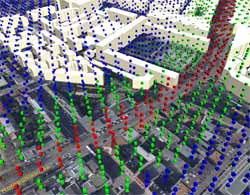3D planning tool for the city of tomorrow

Red, blue and green cubes indicate noise pollution. © Fraunhofer IAO<br>
Fine dust, aircraft noise and the buzz of highways have a negative impact on a city‘s inhabitants. Urban planners have to take a lot of information into consideration when planning new highways or airport construction. What is the best way to execute a building project?
To what extent can the ears – and nerves – of local residents be protected from noise? Previously, experts used simulation models to determine these data. The latest EU directives provide the basis for this. They obtain the data as 2D survey maps; however, these are often difficult to interpret, since the spatial information is missing.
That will get easier in the future: urban planners will be able to virtually move, with computer assistance, through a three-dimensional view of the city. In other words, they will “take a walk” through the streets. No 3D glasses required, though they would be a good idea for the perfect 3D impression. The corresponding values from the simulation “float” at the associated locations on the 3D map – where noise data might be displayed using red, yellow or green boxes. The distances between data points currently equal five meters, but this can be adjusted according to need. The user determines how the map is displayed – selecting a standpoint, zooming in to street level or selecting a bird’s-eye perspective.
This can provide quick help in locating problems such as regions with heavy noise pollution. The 3D map was developed by researchers at the Fraunhofer Institute for Industrial Engineering IAO and the Fraunhofer Institute for Building Physics IBP. “For the simulations, we used standard programs that are oriented around EU directives on noise-pollution control,” says Roland Blach, department head at IAO. “The main challenge was to come up with a user-friendly way of displaying different simulation results.”
Electric cars do not reduce noise levels
Another interesting consideration that the researchers were able to visualize with this tool: if electric vehicles alone were driven in the city, instead of cars with internal combustion engines, how would this change the volume level? What if both gas-driven and electric motor vehicles were on the roads? “Admittedly, you can barely hear electric cars when starting up. At about 30 kilometers per hour, however, you start to hear rolling noises that can get really loud at speeds of 50 kilometers per hour.
Initial simulations found that the conventional simulation models stipulated by public agencies tend to average too sharply: we have yet to see any significant difference in the noise level in electric vehicles or gas-driven cars, since apparently it‘s the rolling noise that predominates,” says Blach. Researchers are presenting these simulations, using Stuttgart as an example, at the Hannover Messe from April 23–27 (Hall 26, Booth C08).
The 3D map is only one of the tools developed by researchers in the “Virtual Cityscape” project. Another is parametric modeling. Here, a structure is designed such that any subsequent changes to dimensions can be made simply by entering the new measurements. If new buildings are to be planned, the scientists first analyze the logistical flows. How many people pass through which halls and corridors? What goods have to get through?
“The program takes these usage parameters into account, and automatically incorporates them into the planning,” explains Blach. For example, if only standard windows are supposed to be used in a building, and the architect enlarges a space, then the program automatically places the windows at the appropriate distances or even inserts another one if space allows.
Media Contact
All latest news from the category: Architecture and Construction
Newest articles

NASA: Mystery of life’s handedness deepens
The mystery of why life uses molecules with specific orientations has deepened with a NASA-funded discovery that RNA — a key molecule thought to have potentially held the instructions for…

What are the effects of historic lithium mining on water quality?
Study reveals low levels of common contaminants but high levels of other elements in waters associated with an abandoned lithium mine. Lithium ore and mining waste from a historic lithium…

Quantum-inspired design boosts efficiency of heat-to-electricity conversion
Rice engineers take unconventional route to improving thermophotovoltaic systems. Researchers at Rice University have found a new way to improve a key element of thermophotovoltaic (TPV) systems, which convert heat…



